Durham is most famous for its historic cathedral, which is the final resting place of St Cuthbert – the patron saint of North England. In fact, this cathedral city was built when the monks of Lindisfarne and their successors found this place in Dun Holm (means Hill island) in 995 AD, after 200 years of wandering with the Saint’s coffin. The current structure of the Durham cathedral was built in the late 11th century after the Norman conquest. Since then, until the early 19th century, the bishops had enormous power and they became known as Prince Bishops. Like a Royal family, they used to live in the Castle. The Cathedral and the adjoining castle are UNESCO World Heritage sites. This city is steeped in so much history that you would love to explore.
There are plenty of fun activities as well that you can do in Durham. You can row on the River or take a cruise on the Prince Bishop, you can take a walk along the river, enjoy some yummy treats on the Market Place. UK’s largest light festival, Lumiere Festival takes place here every two years. Plus, being a University town, It has great food and pub scene.
Getting to Durham:
Hop on the LNER train which runs along the east coast of England. It takes almost 3 hours from London and about 1 hour 45 minutes from Edinburgh. If you are coming from Manchester, Transpennine Express runs frequent train services to Durham. It would take almost 2 hours 15 minutes.
Most of the attractions in this cathedral city are within walking distance from the city centre.
🇬🇧 22 Best Things to Do in Durham
1. Visit Durham Cathedral

The Cathedral is the most important attraction in Durham. It’s possibly the most famous cathedral in the whole of Britain. After the Norman Conquest of England, this cathedral was built in the late 11th century. So, clearly, the architecture of the cathedral has significant Norman influence. Step inside this UNESCO World Heritage site and explore its 1000 years of fascinating history. A few must-see things in the cathedral:

1.1. The Treasures of St Cuthbert
St Cuthbert is the patron Saint of North England. In his 20s, he became prior of Melrose, and then the bishop of Lindisfarne before living as a hermit on the Inner Farne Island. After his death, he was buried in Lindisfarne. But with the Viking Raids in 700s AD, the monks of Lindisfarne and their successors carried his coffin over a couple of centuries before finding his final resting place in Durham in the late 900s AD.
1.2. Venerable Bede’s Tomb
Bede was a legendary Anglo-Saxon scholar in the 7th and 8th century. He is considered the father of English History. He brought the idea of recording time in AD (Anno Domini) and popularised it in Europe. His bones are interred in the Galilee Chapel inside the cathedral.

1.3. The Cloisters
The impressive cloisters of the Durham Cathedral were featured in Harry potter film and Avengers: Endgame.
1.4. The Sanctuary Knocker
The Sanctuary Knocker appears on the Cathedral’s North door – resembles a ring hanging from the mouth of a beast. In past, a criminal seeking refuge in the cathedral would bang on the knocker and grab the attention of the watchers of the Cathedral. After entering the cathedral, the sanctuary seeker then had to change his clothes to a black robe with St Cuthbert’s Cross sewn on the left shoulder. Before 37 days of sanctuary ends, the criminal had to leave.
1.5. The Neville Screen
The Nevilles were one of the most influential families in Durham who fought the Scots earning English Victory in the Battle of Neville’s Cross in 1346. They gifted an ornamental screen, called the Neville Screen which was erected on the Cathedral in 1380. Neville families were allowed to be interred in the cathedral, a very rare honour at that time.
1.6. Stained Glasses
Durham Cathedral has some of the finest stained glasses in the UK. Take a walk in tranquillity and admire the glassworks. Some of them are 700 years old.
1.7. Highest Cathedra
The bishop’s throne (called Cathedra) in the cathedral is an inch higher than the Pope’s. Legend has it Bishop Thomas Hatfield sent some of the monks to the Vatican city to measure the height of the Pope’s thrones so that he could build the highest cathedral throne in the world.
2. Visit Durham Castle
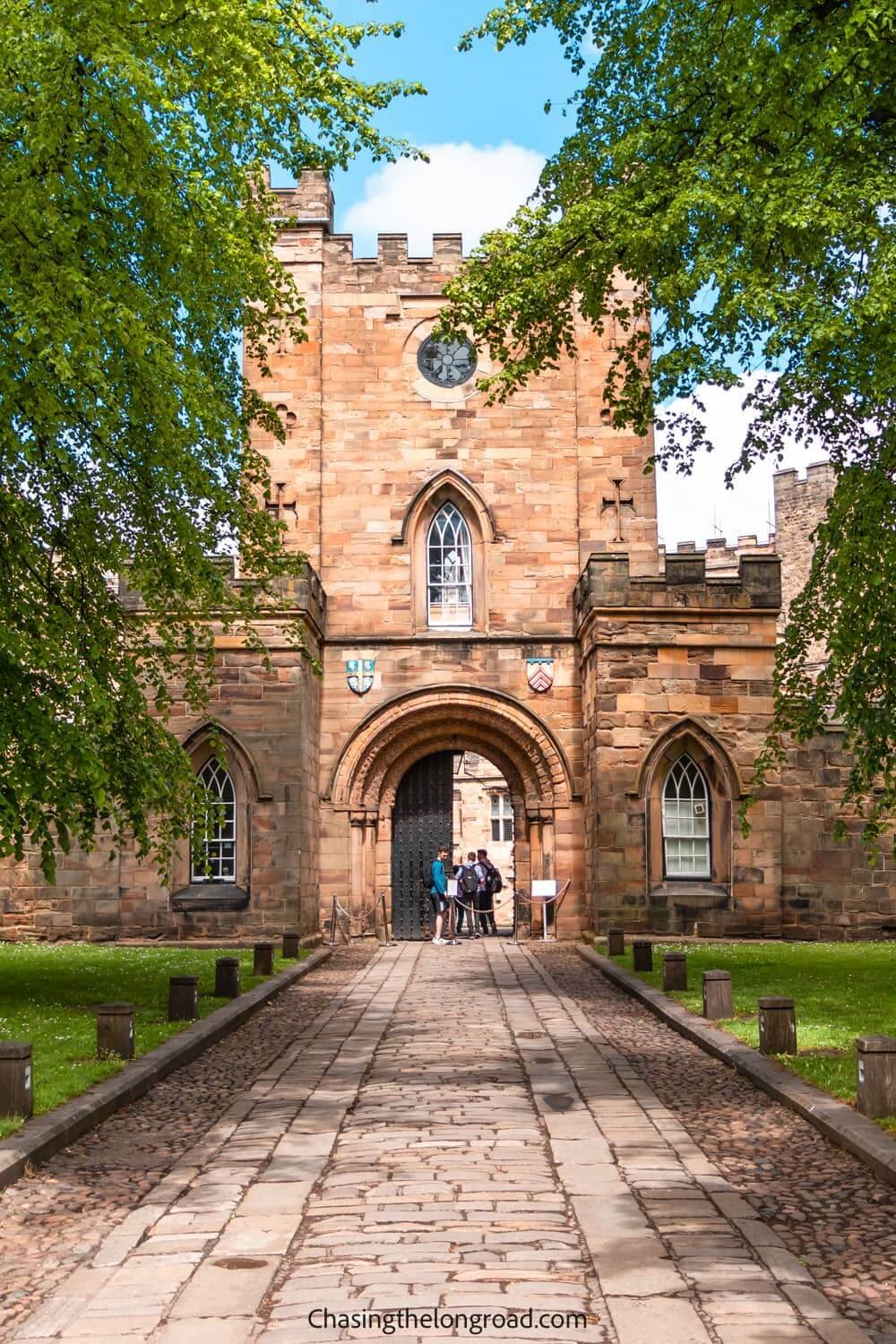
Located on a small hill overlooking the River Wear, Durham Castle is one of the top attractions in this city. This Norman Castle was built in 1072, and since then, it served as the official residence of the Prince Bishop. After 1832, Auckland Palace became the official residence of the bishop. Then this castle was donated to the University of Durham. In 1986, The castle along with the cathedral received the UNESCO World Heritage site status.
You can only access this castle today by guided tours. If you fancy a stay in this castle, they have B&B accommodations during University vacations when. They have a couple of State Rooms available to stay throughout the year.
3. Durham Riverside Walk
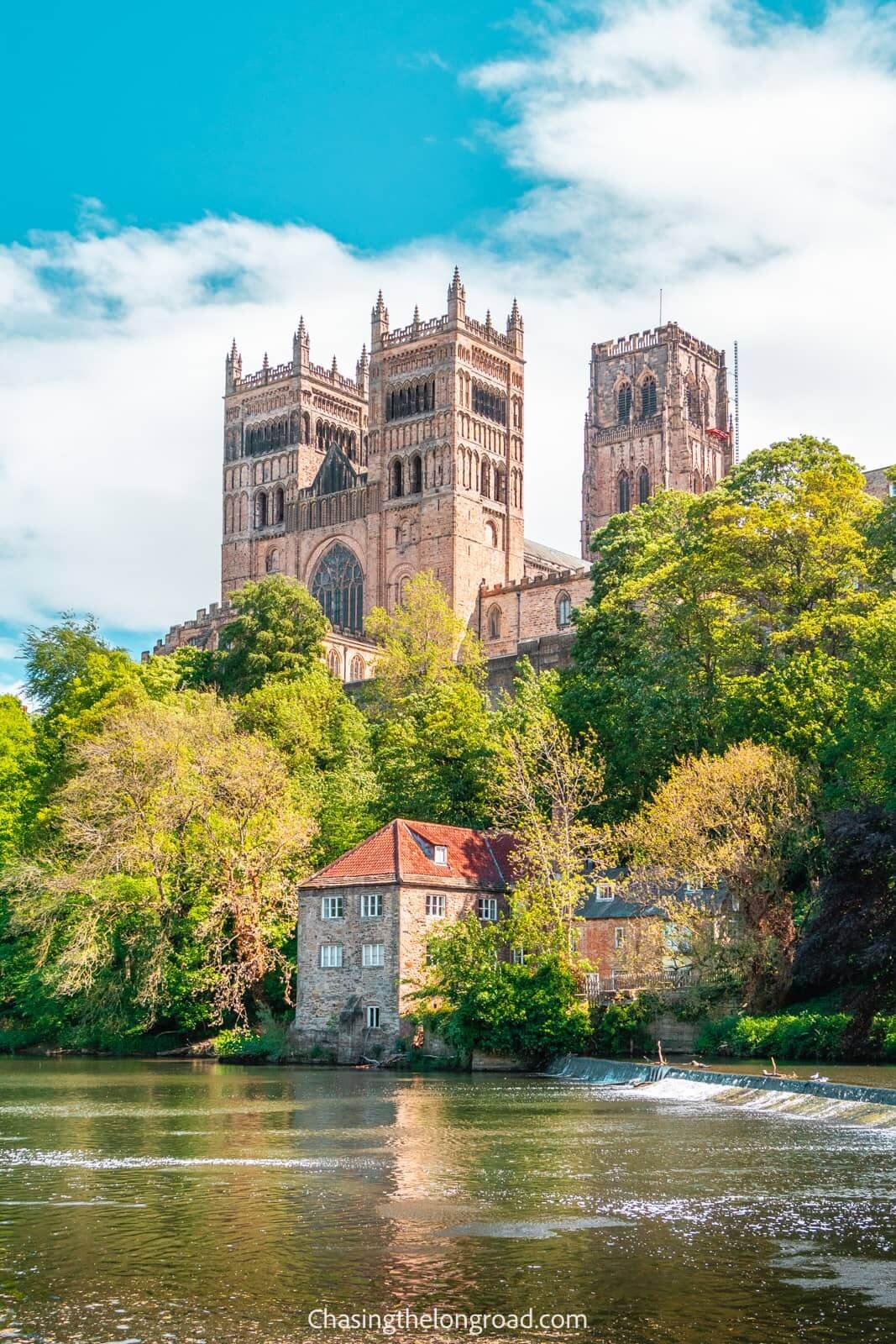
No visit to Durham would be complete without the Riverside walk. A stroll around the River Wear would be a great way to feel this cathedral city. You will get a stunning view of the Cathedral overlooking this river. It would take you about 1.5 hours to complete the 3-mile circular walk. Riverside Walk is one of the best things to do in Durham.
From the stone arched bridges – Framwellgate Bridge, Prebends Bridge, Elvet Bridge – you would get a fantastic view of the River Wear and the surrounding landmarks.
You can also hire a rowing boat or take a cruise along the River Wear on the Prince Bishop.
4. Durham Market Place

Come any Saturday in Durham. You will find a bustling outdoor market in Market Place at the heart of this cathedral city. There are plenty of independent shops and crafts where you can pick a bargain.
If you are in for street foods, you are in luck. There are a number of yummy pop-up food stalls in this market. We bought ourselves a couple of gyros from a Greek food vendor. It was really good.
Also, watch out for the statue of Neptune and the Man on the Horse on the Market Place.
5. Durham Town Hall

Durham Town Hall is definitely one of the top attractions in this city. Originally Built in the 1300s, the building went through several alternations and extensions over centuries. The centrepiece of the Durham Town Hall is The Great Hall – 72 ft long wood-panelled hall with wooden plaques and coats of arms of prominent local families.
It’s free to visit. You will get to know a great deal of local history about the Prince Bishops, Trade Guilds, Józef Boruwłaski – a Polish-born dwarf musician (popularly known as the Little Count) who retired in this city.
6. Visit Finchale Priory
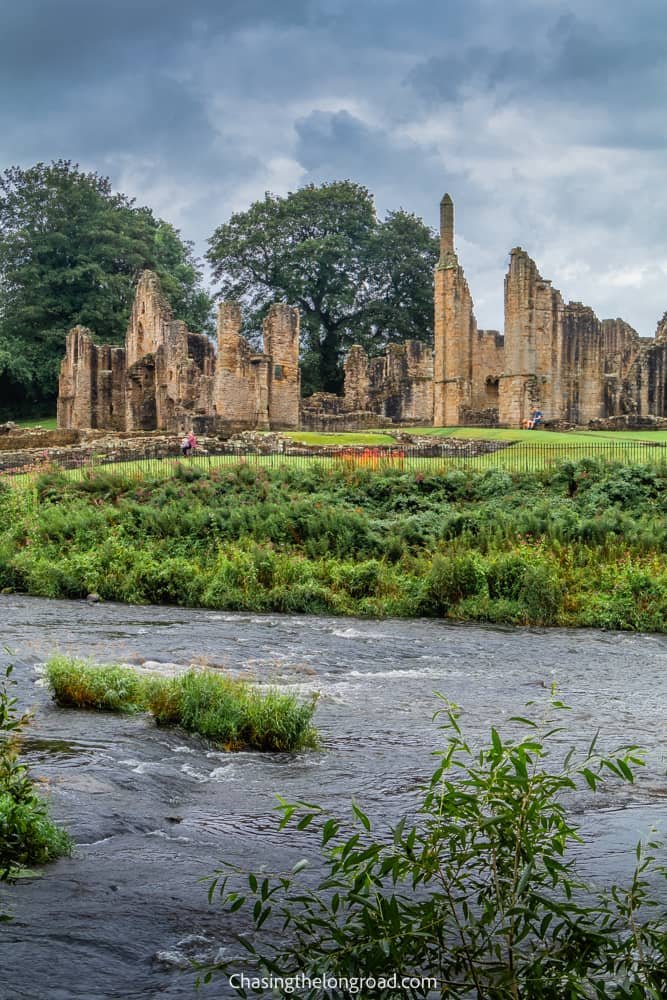

About four miles north of Durham City Centre, you would find the impressive ruins of Finchale Priory (pronounced ‘finkale’). Nestled on the bank of River Wear, this priory was founded in the late 12th century. It was used as a holiday retreat for the monks of Durham Cathedral until the dissolution of monasteries in the 16th century.
Cross over the bridge adjacent to the priory and walk over the other side of the River Wear. You would get a magnificent view of the priory. It’s free to visit. If you are coming here by public transport, take bus service 62 from the city centre. You would have to walk about 15 minutes from the nearest bus stop.
7. Take a culture trip to Oriental Museum


This museum boasts of having more than 36,000 Egyptian, Chinese, Japanese, Indian, Korean artifacts. Laid out in four different floors, the museum is a treasure trove of Egyptian collections – It’s definitely worth a visit. This museum under Durham University is about 20 minute’s walk from the city centre. It’s totally free to visit.
8. Visit Durham Museum and Heritage Centre
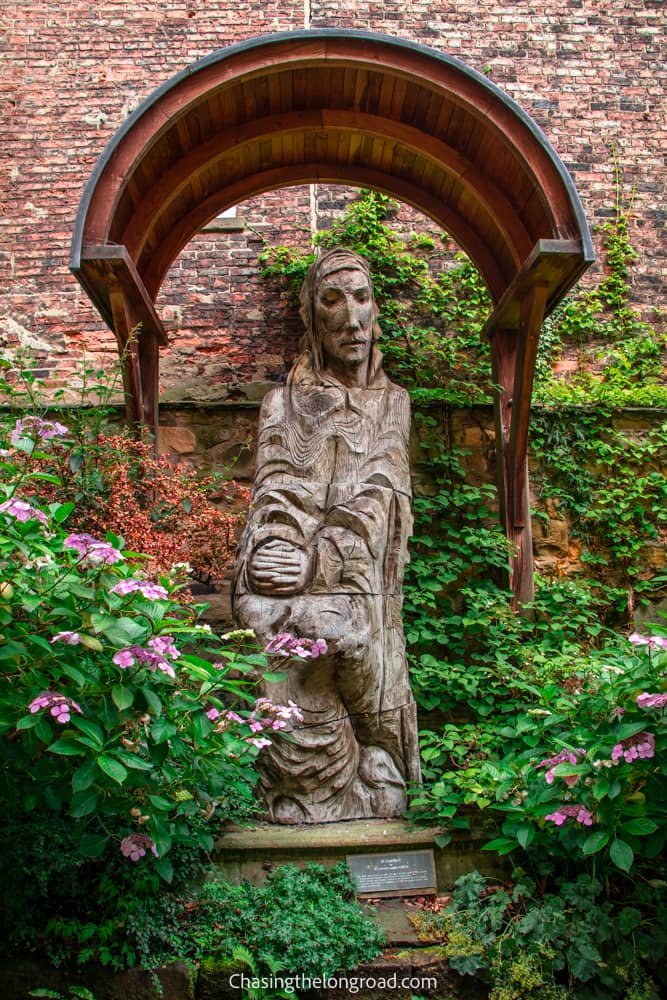

A short walk from the cathedral lies Durham Museum and Heritage Centre. Long ago, it was a parish church of the North Bailey. You would get to learn some fascinating stories about Prince Bishops and a great deal of local history including the mining industry of the city and its surrounding areas.
In the churchyard, you would find impressive wood sculptures of St Cuthbert and Gaia by Fenwick Lawson – a renowned sculptor of North-East England. Entry fee to this museum is £2.50 per adult.
9. Pay a visit to Durham Market Hall
Don’t miss this historic indoor market at the heart of city centre. Established in 1851, this is one of the very few privately owned markets in the country. You would find a wide range of local produces, clothing, butchery shops. It’s open six days a week from Monday to Saturday. There is a nice café upstairs as well.

A few yards off the Market Hall stands Prince Bishops Place – an array of department stores, retail shops and cafes.
10. Explore the historic buildings around Palace Green

Though the name gives you the impression about a palace, this is actually a green space between the Durham Cathedral and the Castle. This was the site of the old market place consisting of wooden houses until the 12th century. Then, it was moved to its current location to prevent the potential fire hazards. Not only the Cathedral and the castle, there are a number of historic buildings around the Palace Green. Explore Bishop Cosin’s Hall – a Georgian house, Pemberton Building and Palace Green Library.
11. Wander around Wharton Park
Durham Wharton Park is located very close to the train station. This open green space is named after William Lloyd Wharton – a local wealthy coal mine owner and barrister, who built the park in the mid 1800s. This park gives one of the best views of the city skyline dominated by the cathedral.
12. Visit Museum of Archaeology


Located in Palace Green Library, Museum of Archaeology displays artifacts from prehistoric to Roman period in Durham. Highlights include Lanchester Diploma, discovered in 2016 – first of its kind in the country. It’s quite small museum but worth a visit if you are interested in history. You don’t have to pay a penny to visit this museum.
13. Enjoy a fun-packed day in Beamish Museum

Located halfway between Durham and Newcastle, Beamish is a 350 acre open-air museum where you can time travel to the Victorian and Edwardian eras of North East England. It’s like you are in the set of a period drama. Hop on to the vintage bus (free service – included in the ticket) and explore different sections of the museum. You can also shop and taste many nostalgias of the past like Victorian lemonade, Rowntree’s chocolates, bakeries made with Edwardian recipes. Truly a gem of North East England, this Living Museum of the North is a perfect package of entertainment and education for all ages.
Beamish is just about 15 minutes’ drive from Durham. There are frequent public bus services as well from the city centre. Entrance fee to the museum is £19.50 per adult which includes your yearly pass. You can visit the museum as many times as you want in a year without paying anything extra.
14. Explore the seaside town of Seaham, Durham County


Seaham lies about 14 miles northeast of this city in Durham county. Visit the Seaham Harbour, founded by the 3rd Marquess of Londonderry, Charles William Vane Stewart. Through his marriage, he became a coal mine owner. When his plan to export Coal via the River Wear was denied, he built this harbour for exporting coal quarried from the nearby Collieries. Most of the collieries closed their doors by the end of the 20th century. Today Seaham is a picturesque coastal town.
Seaham has a history with world-renowned poet, Lord Byron who was married at Seaham Hall in the early 19th century. He stayed in this town for a brief period with his in-laws. Now, Seaham Hall is a luxury hotel and Spa with award-winning restaurants. Also, the shopping Mall at the heart of this small town is named after Byron.
On the coast, don’t miss the 10 feet tall sculpture, ‘Tommy’ that commemorates the soldiers in the First World War.
15. Take a walk along the scenic Durham Heritage Coast
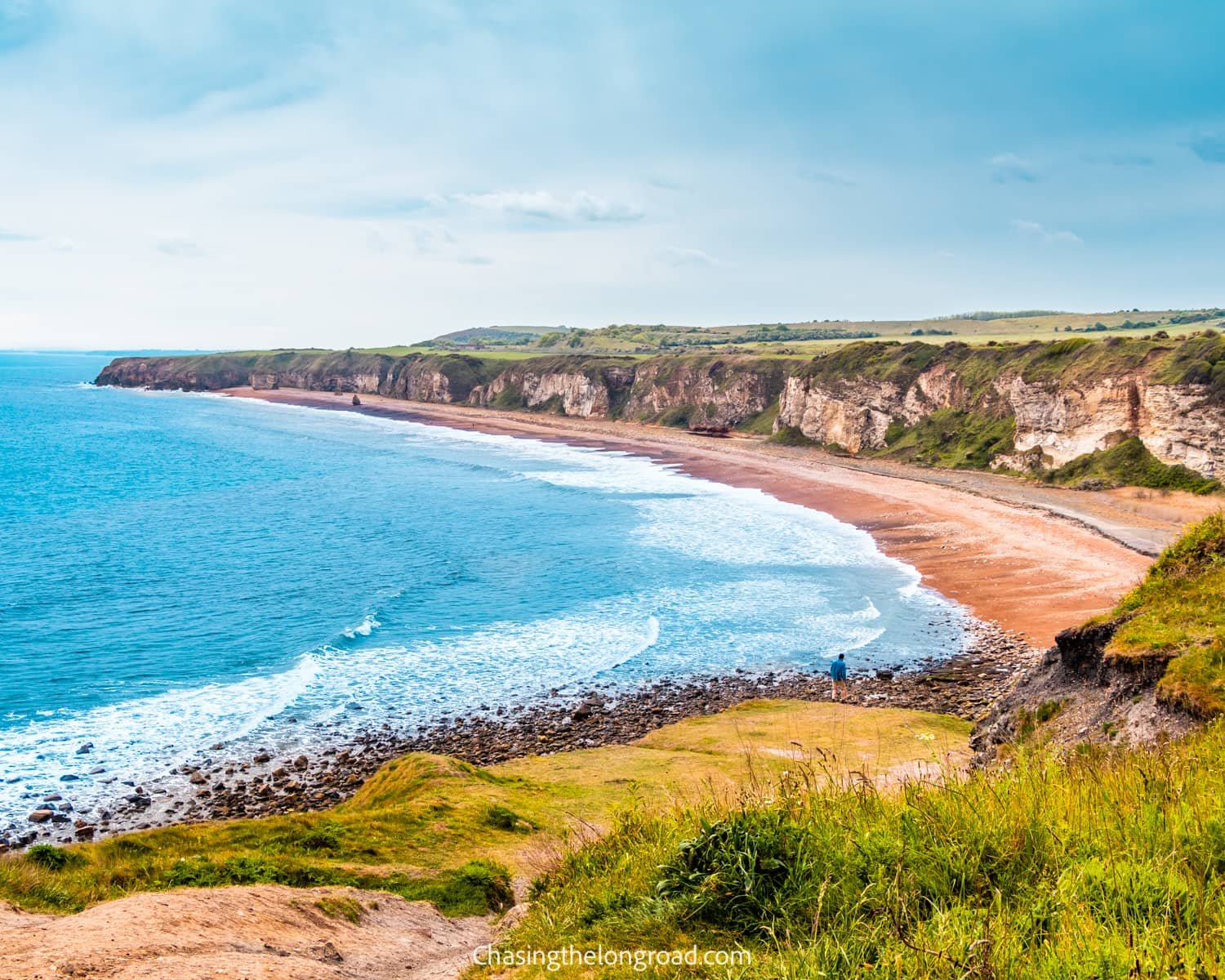
Durham coastline runs from Sunderland in the North to Hartlepool in the south. There are two famous beaches on this coast not too far from the Seaham town centre – Chemical Beach and Blast Beach. They are separated by a headland, called Nose’s Point. Though the names sound quite scary, the beaches have healed the past scars of industrial waste dumps. They have been beautifully restored by a major clean-up project called ‘Turning the Tide’. The Durham Coast has received Heritage Coast Status.
Today, you would get to enjoy impressive magnesium limestone cliffs on your coastal walk.
16. Explore some lovely cafes in Durham
Durham has a very vibrant café culture. We heard very good reviews about this one – Flat White Kitchen. Very popular with tourists and locals alike, you would always find some people waiting outside this café. They have a wide range of choices for breakfast and brunch. We popped in there for breakfast. Moumita had an Egg Florentine, and I had a pancake with blueberry compote – Amazing food, lovely welcoming staff and cool atmosphere. would definitely recommend a visit.


We went to another nice café, Cafedral Durham for light lunch. Located a few yards away from the castle, their scones were really tasty. Very good service and friendly staff. Worth a visit.
17. The Statue of Neptune

Located on the Market Place, The statue of Neptune (a Roman god associated with the sea) symbolises an ambitious 18th-century plan to make the River Wear navigable from Durham to Sunderland altering the course of the river. But that plan never materialised as it was deemed impractical.
18. The Man on the Horse

The equestrian statue on the Market place is of Charles William Vane Stewart, the 3rd Marquis of Londonderry. He had a colourful military career in the 1800s and the statue shows him in military uniform. He founded the Seaham harbour.
His statue was created in 1861 by an English sculptor of Italian origin, Raphael Monti. A story goes that the sculptor was so proud of his work that he challenged that if anyone can find the slightest fault in his work, that person would be rewarded. Apparently, a blind man found out that the horse doesn’t have a tongue. That completely upset the sculptor and he committed suicide. Though today it’s highly doubted about the accuracy of this story.
19. Take a Sip with Riverside View


Durham has a bustling pub scene. There are plenty of amazing pubs and restaurants dotted on the banks of River Wear and the city centre. We were at Cosy Club, which has a few stores in the UK – we are big fans of their décor and atmosphere. We took a couple of cocktails and a few tapas. Nothing beats refreshing cocktails on a summer day! They have a few spots at the balcony as well where you can sip the cocktail with a smashing view of the cathedral overlooking the River Wear.
The Bishops Mill, Ye Old Elm Tree, The Library, Market Tavern are also some of the popular pubs in this cathedral city. Apart from the usuals, they have a great selection of local beers brewed by the Durham Brewery.
20. Attend Festivals and Events


UK’s largest light festival, Lumiere Festival takes place in this cathedral city in November every two years. That’s the most popular event in Durham. Plus, the Pride event happens every summer. On our trip, we got to catch a glimpse of this event attended by around 25,000 people.
Durham Book Festival is held every October in the local historic buildings that include the Cathedral and the Town Hall. This city also hosts a very unique event, Miner’s Gala.
21. Visit other attractions in County Durham


Auckland Castle, Raby Castle, Bowes Museum, Head of Steam Darlington Railway Museum, Eggleston Abbey are some of the other top attractions in County Durham. Those are excellent choices to extend your trip by a couple of days.
22.Take a day trip to Newcastle
After soaking up the cultural heritage of Durham, want to have some fun and party hard? Head towards Newcastle – the city of seven bridges and the party capital of North England. Newcastle is around 15 minutes by train and half an hour by car from Durham. This bustling city has been voted the third best nightlife destination in Europe. Newcastle has its historic Grainger Town, an amazing waterfront, a Chinatown, a medieval castle. Not only that, some of the best beaches in the country are also not too far from Newcastle. With so many things to do and see, you could easily spend a few days (even a week) in Newcastle.
Planing a Trip to England?
For further reading on other ENGLAND destinations:




